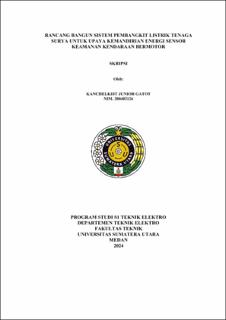Rancang Bangun Sistem Pembangkit Listrik Tenaga Surya untuk Upaya Kemandirian Energi Sensor Keamanan Kendaraan Bermotor
Design and Integration of a Solar Power System to Support Energy Self-Sufficiency of a Sensor Based Vehicle Security System

Date
2024Author
Gatot, Kanchelkist Junior
Advisor(s)
Mubarakah, Naemah
Bukit, Ferry Rahmat Astianta
Metadata
Show full item recordAbstract
Electricity is an important source of energy, widely used and integrated in
society’s daily functions. With its ever-increasing usage, an alternative method of
producing electricity that doesn’t rely on environmentally negative affecting non
renewable energy sources is required. One of those alternative renewable sources is
solar power. Motor vehicles are one of the most prolific methods of transportation used
by almost everyone. This proliferation often marks them as prime targets of theft. As
reported by the residents of the perumahan Villa Palem Kencara, where there have been
2 cases of grand theft auto in the past month. To assist the residents, the installation of a
security device utilizing a RFID sensor has been proposed. However, the lack of
additional power sources on location should the local PLN grid suffers a power outage,
creates a potential weakness for the security device. This paper aims to design a solar
power generating system to ensure the security device’s energy self-sufficiency and help
mitigate a potential vulnerability of the device. This research analyses the performance of
the solar power system, the average total energy consumed by the security device and the
power system’s battery self-sufficiency. The design of the power system couples the solar
power plant with the local PLN grid through the use of an automatic transfer switch
(ATS), if one source was to experience an outage, the ATS system will switch between
power sources. Thus, maintaining the security device’s energy self-sufficiency. From the
testing process the solar power system is shown to be able to power and fulfill the energy
self-sufficiency requirements of the security device. From testing the security device, the
average energy consumption was found to be 3.1W or 24.8 Wh in stand-by mode and
11.2W or 89.6 Wh in work mode, with an operational time of 8 hours. The solar power
plant was able to generate on average 32W or 256 Wh of energy for 8 hours. The battery
used is able to power the security device independently for 8 hours without recharging
until a depth of discharge of 50%.
Collections
- Undergraduate Theses [1534]
